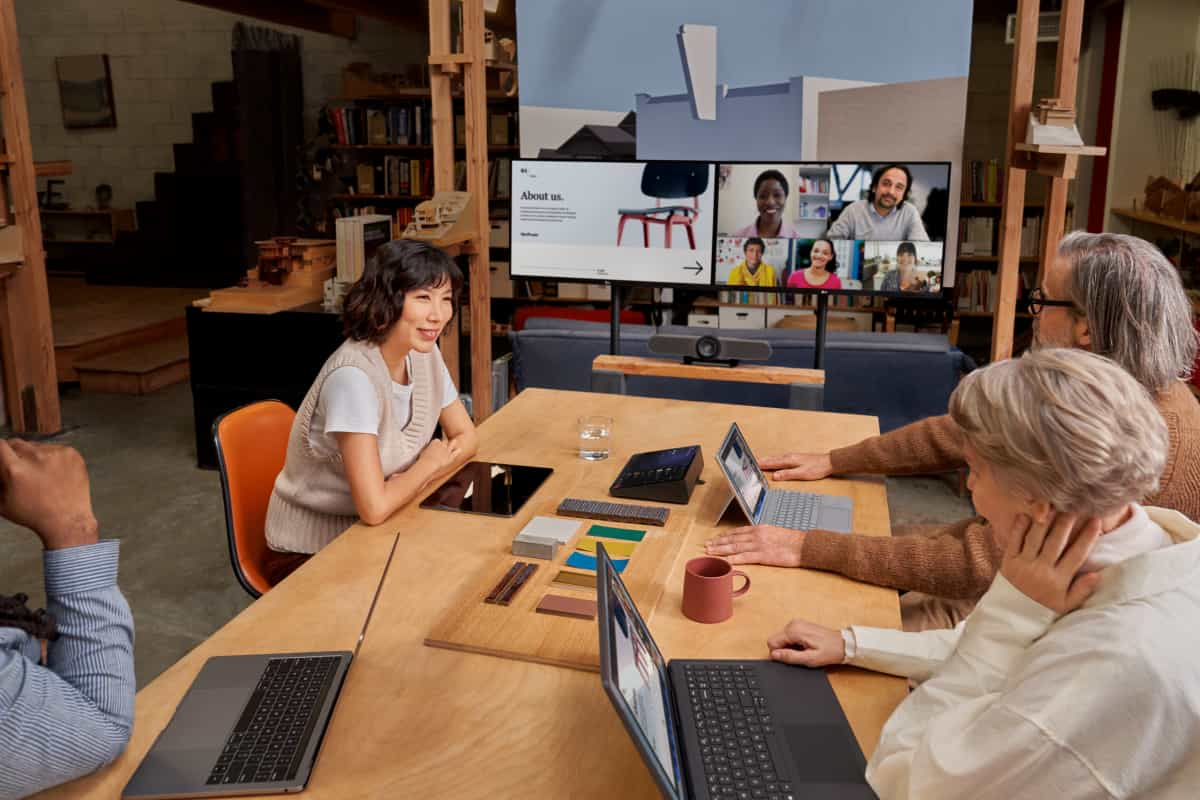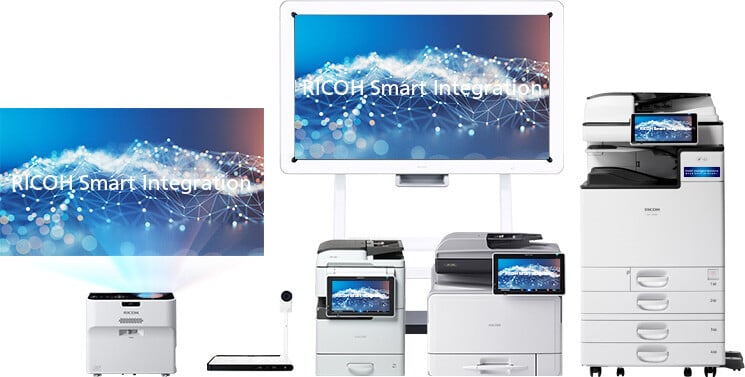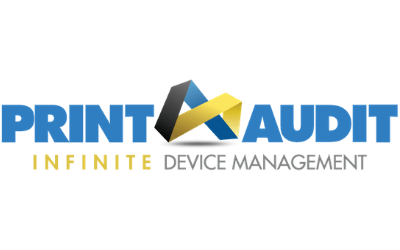Office Software
Streamline Your Processes, Increase Productivity and Encourage Collaboration.

We carry several different software products, but they are all designed to do one (or more) of three things: help you control your printing costs, move towards a paperless office and collaborate more effectively.
Before we dig into the individual products, let’s look at what that means.
Software to Enable Collaborative Work
Our collaborative software solutions help you simplify teamwork by:
- Providing a single collaborative digital space for projects that can be shared across multiple screens simultaneously
- Allowing colleagues to sketch ideas, share progress, and import files with each other from desktops, laptops, and mobile devices
- Creating timelines and tasks for projects that can be shared and assigned to users both inside and outside the organization
- Connecting people through video calls and meetings
Software to Provide Electronic Content Management (ECM)
Our document management software provides your team with solutions that:
- Streamline the capture, storage, processing, and retrieving of files
- Allow authorized users to access information remotely
- Reduce the need for relying on couriers
- Design customized invoices, reports, and other business documents
- Trigger printing and emailing processes automatically
- Covert complex PDF documents into a wide variety of formats and vice-versa
Software to Control Printing Costs
This software allows you to:
- Analyze the printing habits of employees to uncover workflow inefficiencies and high-cost printing activities
- Create automated sets of rules and guidelines that ensure print jobs are directed to the most cost-effective printer
- Track, allocate and bill each print job to the appropriate client
- Secure sensitive documents and prevent them from sitting unattended in printer trays
- Automatically monitor supplies and service information for individual printers, copiers, fax machines, and multi-function devices
What Software Solutions Do We Provide?
Microsoft 365
M365 is Microsoft’s suite of office products, including all your standard Microsoft Office applications such as Outlook, Word, Excel and PowerPoint but also many more brand-new apps that many users have not heard of.
A few of our favourite “new” apps you can leverage with M365 are Teams, OneDrive, OneNote, SharePoint, Flow, Planner and Bookings. View the full list of apps included in M365 here.
Unlike earlier versions of Microsoft Office products where you purchased a license for a one-time fee and then installed and ran that license from a PC or server, M365 is cloud-based, and pricing is a monthly or annual subscription.
Why use M365? What are the benefits?
There is a reason that M365 is currently the most popular subscription-based application in the market and is being adopted by some of the largest organizations in the world. Let’s examine the key benefits of moving to M365.
1. Data security
Microsoft provides a fully managed and monitored infrastructure with security measures, automatic data backups, and encryption to protect you and your data. Storing your Office suite in the cloud ensures your data and software remain protected no matter what happens to your hardware.
2. Stay up to date
When using M365 rather than a server-based version of Office, you’re always up to date with the latest versions of Office apps and security features. This is incredibly important, as ransomware and malware can exploit vulnerabilities in programs that haven’t been updated in a while. Nearly 40% of cyber-attacks target SMBs and 60% of small companies go out of business within six months after a cyber-attack!
3. Work anywhere, anytime
People need to be able to have access to work remotely regardless of where they are in the world. Microsoft 365 helps you do that. Being able to access your apps, files, emails, and more from any device is both convenient and productive.
4. Collaborate more effectively
Leverage M365 apps to hold video calls and meetings, collaborate simultaneously on files, plan and manage projects (and then assign tasks within each project to specific individuals) and schedule meetings.
5. Eliminate IT infrastructure costs
Since M365 is in the cloud, you will no longer need to own and maintain a server to manage your email and internal file storage/sharing. No longer will you have to invest tens of thousands of dollars into server hardware and professional IT services to protect that hardware. When Office Interiors migrated to M365, we saved over $25,000 annually by eliminating these IT infrastructure costs!
Downsides to M365?
Most customer feedback on M365 is overwhelmingly positive; if it weren’t, it would not be the fastest-growing subscription business software in the world. However, there are a few considerations to keep in mind before you take the plunge.
First and foremost is the requirement of reliable internet access to use most of your M365 programs. Some of the applications (ex. Word, Excel, Outlook) have desktop versions, but they are not available in the entry-level packages (Microsoft 365 Business Basic). Business Basic can only be used through a browser and requires an internet connection.
You should also keep in mind that since M365 is in the cloud, it means you will need to rely on Microsoft for your data security. While this is usually considered a benefit, for some organizations moving their data to the cloud where they can’t as directly control its security is simply a deal-breaker.
The final important consideration is that M365 is a subscription service and cannot be purchased outright. This means that your licenses will renew either monthly or annually (depending on the plan you select) in perpetuity. Again, some businesses consider this a benefit as they no longer need to budget for periodic bulk license buys, but it does mean that you will need to carefully monitor just how many licenses will automatically renew every month or year.
How much does M365 cost?
Microsoft 365 pricing is based on the number of licenses (users) you want to purchase. There is not much price discrepancy between providers, virtually all resellers of M365 sell each license for the MSRP suggested by Microsoft. The table below shows the pricing plans and features for each of the three most popular packages:
| Pricing Plans | Business Basic | Business Standard | Business Premium |
| Base/Web Direct price per user per month $CAD (with an annual commitment) | $8.10 | $17.00 | $29.80 |
| Features Included | – Web and mobile versions of Word, Excel, PowerPoint, and Outlook – Chat, calling, and meeting with teams from laptop, tablet, or phone – Appointment booking and management with Microsoft Bookings – Project management tools including Microsoft Forms, Microsoft Lists, and Microsoft Planner – 1 TB of cloud storage per user – Business-class email (name@yourbusiness.com) – Standard security – Anytime phone and web support |
– Web and mobile versions of Word, Excel, PowerPoint, and Outlook – Chat, calling, and meeting with teams from laptop, tablet, or phone – Appointment booking and management with Microsoft Bookings – Project management tools including Microsoft Forms, Microsoft Lists, and Microsoft Planner – 1 TB of cloud storage per user – Business-class email (name@yourbusiness.com) – Standard security – Anytime phone and web support |
– Device management – Ability to remotely wipe lost or stolen devices – Advanced security tools and features – Controlled access to company data Cyberthreat protection – Access to advanced IT support is recommended. |
| Apps and Services | Secure Cloud Services: Microsoft Teams, OneDrive, SharePoint, Exchange. Web and Mobile Apps Only: Word, Excel, PowerPoint, Outlook. |
Desktop, web, and mobile apps and secure cloud services: Word, Excel, PowerPoint, Outlook, Microsoft Teams, OneDrive, SharePoint, Exchange, Publisher (PC Only), Access (PC Only). |
Desktop, web, and mobile apps and secure cloud services: Word, Excel, PowerPoint, Outlook, Microsoft Teams, OneDrive, SharePoint, Exchange, Publisher (PC Only), Access (PC Only), Intune, Azure Information Protection. |
There is no requirement that you provide all your employees with the same license package. For example, your administrative team may need the full Business Standard or Premium subscription, but if you have a team of mobile service technicians like we do, they may only require Business Basic since they do not require the full suite of applications or the ability to download the desktop version of those apps.
On top of each of these license packages, there is a wide variety of add-ons that provide additional features, services or analytics. Much like subscription types, you don’t need to give every user every add-on; you can mix and match depending on the requirements of individual users. The next table breaks down a few of the most popular.
| Add-on | Description |
| Office 365 Advanced Threat Protection (Plan 1) | Email filtering service that protects against malware and viruses. This includes Safe Links, Safe Attachments, and Anti-phishing policies. |
| Office 365 Advanced Threat Protection (Plan 2) | Email filtering service that protects against malware and viruses. Includes Plan 1 + Threat Tracker, Explorer, Simulator and Automated Investigation/Response |
| Online Archiving for Exchange | Assists with archiving, compliance, regulatory, and eDiscovery while simplifying on-premises infrastructure, reducing costs and easing IT burdens. |
| Extra File Storage | If you start to run out of storage for your SharePoint Online site collections, you can add storage to your subscription. |
| Data Loss Prevention | Allows a company to prevent confidential data from leaving their company via email or being communicated via email (internal or external). |
| Audio Conferencing | A licensed user can generate an audio-conferencing bridge that allows attendees to dial into their meetings via an audio conference bridge. |
| Microsoft CoPilot | Microsoft 365 Copilot is an AI-driven productivity tool that integrates with Microsoft 365 apps to enhance creativity, productivity, and seamless task management with enterprise-grade security. |
How Do You Choose The Right M365 Plan for Your Business?
Here’s a 5-step guide to choosing the right Microsoft 365 plan for your business.
- Assess your current situation – What kind of hardware do you have, and what kind of operating systems do they run? Are all workers using the same office software? Microsoft 365, being cloud-based, seamlessly integrates with various operating systems.
- Understand your needs – Identify your top priorities as you navigate the selection of your ideal Microsoft 365 plan. Is enhancing communication your primary goal? What about boosting productivity and fostering collaboration? Are heightened security measures a key concern?
- Review your budget – Every migration will typically need to account for two budget components. One encompasses the licensing fees for the chosen Microsoft 365 plan, while the other covers the actual migration expenses. If budget constraints are a factor, an in-house migration might be feasible. When determining the number of licensed users, it’s advised to overestimate to accommodate potential growth slightly.
- Compare and select plans – Microsoft 365 offers an array of plans, making the decision process somewhat intricate. Microsoft 365 offers an online plan selector tool which you can take advantage of.
- Reassess and review later – Routine assessment and evaluation of your chosen products is standard practice. Once you’ve had an opportunity to observe how your selected Microsoft 365 plan performs within your business, you can gauge the accuracy of your decision. Your administrators can periodically generate user statistics to identify which apps are most effective.

How Do You Pick Which M365 Vendor is Right for You?
Microsoft 365 is sold not just by Microsoft itself but also by thousands of resellers and vendors online. Most of these vendors will all sell subscriptions at the same MSRP rate as Microsoft. So how do you decide which to buy from?
There are three key points of differentiation you should focus on when determining which vendor you should go with. When comparing vendors make sure you pick one that offers:
- Migration assistance & billing reviews
- Post-implementation support
- Ongoing M365 mastery training
Migration assistance & billing reviews
If you are migrating from an on-premise email solution to a cloud solution like M365 you very likely will require assistance. For a seamless experience, your vendor should either provide this service themselves or have an IT partner with whom they regularly work who can do it for you.
One common customer complaint of M365 vendors is that the billing process is cumbersome, inaccurate or unclear. Select a vendor who is willing to regularly review your billing situation and provides you with an easy way to adjust your plan. The best vendors on the market provide self-serve portals where the customer can immediately add, adjust or remove subscriptions, purchase add-ons and cancel their service outright.
Post-implementation support
Most businesses find that once they have moved to M365 the number of IT service tickets decreases significantly, however, as with any technology, things can still go wrong. Ensure that your vendor provides support for when the inevitable happens and someone on your team requires technical assistance.
Ongoing M365 mastery training
Microsoft 365 is ever-improving, adding new apps and updating the features you rely on every day. You want a vendor who provides more than just access to a license and a payment portal. Your vendor should help you discover new ways that M365 can help your team create a more productive workplace. Some may offer webinars or pre-recorded resources while others may offer in-person M365 training; be sure to ask any potential vendor what they offer.
Should You Buy M365 From a Cloud Solution Provider (CSP) if You Already Have a Microsoft Enterprise Agreement (EA)?
For many years an EA was considered the best way for large organizations to access Microsoft products, now that M365 is accessible through CSPs many are wondering if they should switch.
To compare each option, let’s take a look at a table created by 360 Visibility.
| Cloud Solution Provider (CSP) | Enterprise Agreement (EA) | |
|---|---|---|
| Commitment | No commitment and the option to cancel at any time | 3-Year Agreement, with a minimum commitment of 500 user licenses |
| Invoicing | Monthly | Annually upfront for the full year including being back-charged for users that were added |
| Increase User Counts | Anytime | Anytime |
| Decrease User Counts | Anytime | Once per year – 30 days notice. Need to maintain a minimum of 500 users. |
| Support | 24×7 support from Partner with priority access to escalated Microsoft Premier Support. Dedicated Partner consultants with all details of your account and environment. | Basic support from Microsoft. Additional cost for Premier Support. No dedicated team that knows your account and environment. |
| Detailed Billing | Yes | No |
| Product Availability | All cloud subscription licenses (Dynamics 365, Office 365, Azure) | All Microsoft Products |
As you can see, it ultimately boils down to the level of flexibility offered by an M365 solution purchased through a CSP. An EA contract will lock you in at a predetermined number of licenses (minimum of 500) and you can only downgrade or remove licenses once per year. Whereas we already discussed how an M365 solution allows you to add, upgrade, downgrade or remove licenses at any time.
For much of the office technology market, M365 solutions sold through CSPs have replaced EAs as the most efficient way to access Microsoft’s suite of business products.
Ricoh Smart Integration
40 percent of office workers spend one quarter (25 percent) of their workweek on manual, repetitive tasks, data collection, and data entry.
Ricoh Smart Integration, or RSI, is a subscription service provided by Ricoh to streamline your office’s printing, scanning and filing processes.
RSI encompasses three software products, Essentials, Workflow and Workflow Advanced. These three products are designed to help you automate repetitive manual tasks, convert paper documents into editable formats and store your documents in a secure, organized and easily retrievable manner.

Why should you consider using RSI?
Increase employee efficiency by automating repetitive tasks
If you’ve ever had to scan, email, download, convert, save to a folder, upload or organize files, you know how time-consuming these manual tasks can be. With RSI, you can automate the routing of your documents to the right place, in the right format and with the right file name.
Convert paper documents and PDFs to editable digital files
Never again do you need to recreate a document. RSI can convert PDFs and paper documents to editable Word, Excel or Editable PDF formats.
Mobile & guest printing
Do you have a remote staff or team members who travel between offices? Now they will be able to print to any enabled device without a lengthy configuration process.
Ever have customers, suppliers or partners visit your office and need to print off a document? RSI allows you to let guests print without having to provide them with network credentials.
Avoid a significant capital investment
As a subscription service, RSI eliminates the need for a large capital investment upfront, which has traditionally been one of the roadblocks preventing businesses from implementing these kinds of solutions.
You don’t have to purchase the software, invest in physical infrastructure or pay for ongoing maintenance and support, and you’re always up to date with the latest versions of applications and security features.
Improve scanning and printing security
User Identification with SI-Cloud core consists of ID management, authentication, and verification functions keeping important information behind firewalls. Enforce authentication before printing or routing documents stored in the cloud.
What is included in each plan?
RSI Essentials
- Scan to Email – Scan and convert documents into searchable or editable formats (ex. PDF, Word, Excel)
- Logical file names – Documents are renamed when scanning based on information in the first sentence
- Mobile Print – Employees travelling between offices can print without being on the local network
- Guest printing – Allow guests to your office to print without granting them access to the network
RSI Workflow
- Scan to Email – Scan and convert documents into searchable or editable formats (ex. PDF, Word, Excel
- Logical file names – Documents are renamed when scanning based on information in the first sentence
- Mobile Printing – Employees travelling between offices can print without being on the local network
- Guest printing – Allow guests to your office to print without granting them access to the network
- OCR Scanning – Allows the device to “read” the scanned document, pulling metadata from the document and processing the document based on that metadata
- Scan to Cloud – Scan directly to cloud-based storage solutions such as Google Docs, Dropbox, OneDrive, etc.
- Scan to Local Folder – Scan directly to local network folders
- Route to Multiple Destinations – Route scanned documents to multiple destinations (I.e. documents are routed at the same time to a person in your organization as well as a folder)
- QR Code Recognition & Routing – Create QR Codes which can be used for batch scanning for naming and directing documents
RSI Workflow Advanced
RSI Workflow Advanced includes all the features of RSI Workflow as well as:
- Automatic Document Type Recognition – Teach the system to learn document types and then route them as per pre-set instructions
- Scan to SharePoint (Online Only) and add Metadata at Scanners – Add metadata (file names, etc.) at the scanner so that scanned files are uploaded to SharePoint with searchable metadata
RSI Optional Paid Add-Ons
- Secured print release from a job queue (or job list)
- Secured device access with user authentication, including ID card support
- Device management and status monitoring
- Accounting and Reporting on user and device utilization
- Inbound Fax Routing to a cloud destination
How much does RSI cost?
Each RSI product is priced differently. Essentials is installed directly onto your multifunction printer(s) and is sold as a per-device subscription. On the other hand, Workflow and Workflow Advanced are sold as per-user subscriptions.
Essentials cost approximately $20 per device per month, while Workflow starts at $8 per user per month and Workflow Advanced starts at $12 per user per month. As you add additional user subscriptions to Workflow and Workflow Advanced, there are some volume discounts available, lowering your average per-user price.
Print Audit
Print Audit is a suite of three programs (Analysis, Rules & Recovery) that allow organizations to evaluate, track and control their printing costs. Businesses can choose to implement some, or all, of the programs depending on what they are looking to achieve.
Is your goal to merely gain visibility on your real printing costs, actively manage and reduce your overall printing spend or to enhance the security of your printed documents?

Why use Print Audit?
Print Audit Analysis allows you to track and analyze all the printing going on in your organization. You can determine not just how much printing is done on each device, but how much printing is done by each member of your team. You can finally find who it is that keeps racking up all those colour prints each month!
Once you have analyzed your printing environment, Print Audit Rules gives you the ability to create rules that will govern how your team prints. These rules can either be hard rules that disallow specific actions or soft rules that will generate a pop-up prompt for users encouraging them not to do a particular action.
A few of the most popular rules are to encourage (or force) duplex printing of all large documents or to discourage colour printing of emails, web pages and other non-essential documents.
The third program, Print Audit Recovery, is ideal for professional services companies trying to charge costs back to specific jobs. You can assign particular codes to projects and prompt users for that code at the printer to release their print job. The costs for that print job can then be automatically allocated to the appropriate project or client.
Why use Print Audit?
Print Audit Analysis allows you to track and analyze all the printing going on in your organization. You can determine not just how much printing is done on each device, but how much printing is done by each member of your team. You can finally find who it is that keeps racking up all those colour prints each month!
Once you have analyzed your printing environment, Print Audit Rules gives you the ability to create rules that will govern how your team prints. These rules can either be hard rules that disallow specific actions or soft rules that will generate a pop-up prompt for users encouraging them not to do a particular action.
A few of the most popular rules are to encourage (or force) duplex printing of all large documents or to discourage colour printing of emails, web pages and other non-essential documents.
The third program, Print Audit Recovery, is ideal for professional services companies trying to charge costs back to specific jobs. You can assign particular codes to projects and prompt users for that code at the printer to release their print job. The costs for that print job can then be automatically allocated to the appropriate project or client.
Could New Software Improve Your Bottom Line?
These solutions have helped countless businesses become more efficient, collaborative and productive. Could your business benefit from them as well?
Our team has been helping our customers answer that very question for decades. We will help you calculate the ROI of any software change as well as the opportunity cost for not doing so. You may be surprised at just how steep that opportunity cost can be. Book your free consultation today!
Looking for a reliable Managed IT Solutions provider to take care of all your IT responsibilities, such as managing and securing the office software mentioned above? We recommend Cabco. Click here to learn how Cabco’s Managed IT Solutions are designed to tackle your most demanding IT challenges, allowing you to focus on your core strength.
Have More Questions?
Let's help you answer them.


